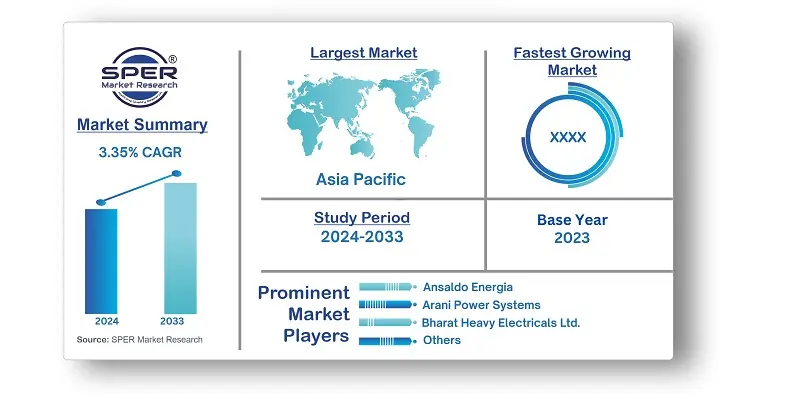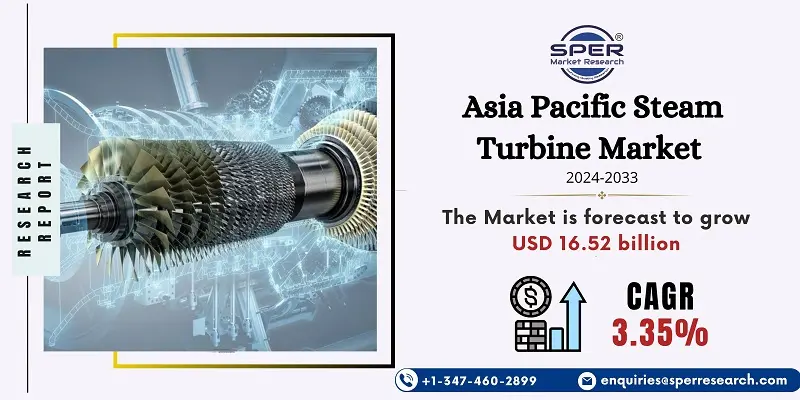
Asia Pacific Steam Turbine Market Growth, Size, Trends, Demand, Revenue and Future Outlook
Asia Pacific Steam Turbine Market Size- By Design, By Capacity, By Technology, By End User- Regional Outlook, Competitive Strategies and Segment Forecast to 2033
| Published: Aug-2024 | Report ID: POAE2475 | Pages: 1 - 155 | Formats*: |
| Category : Power & Energy | |||
- In February 2023, GE introduced its latest H-Class steam turbine, which is designed for more efficiency and reliability than its predecessors. The H-Class turbine is expected to be used for a wide range of power production applications, including fossil fuel, nuclear, and renewable energy sources.
- Siemens Energy delivered a steam turbine, two generators, one gas turbine, and related auxiliaries to power plants in Guangdong, Hong Kong, and Macao, Southern China, in March 2022. The company struck another agreement with Shenzhen Energy Group and Guangdong Energy Group to engage and update power plants, which will increase demand for steam turbines in the region. In addition, the company's current coal-fired power plant will be converted into a high-efficiency gas-fired facility, reducing carbon emissions by up to 60%.


| Report Metric | Details |
| Market size available for years | 2020-2033 |
| Base year considered | 2023 |
| Forecast period | 2024-2033 |
| Segments covered | By Design, By Capacity, By Technology, By End-Use |
| Regions covered | China, Japan, India, South Korea, Australia, Indonesia, Others |
| Companies Covered | Ansaldo Energia, Arani Power Systems, Bharat Heavy Electricals Ltd, Dongfang Electric Company, Doosan Skoda Power, Fuji Electric Co. Ltd, General Electric (GE) Co, AIstom SA, Kawasaki Heavy Industries, Man Diesel & Turbo SE, Mitsubishi Hitachi Power Systems, Nanjing Turbine & Electric Machinery, Siemens AG, Toshiba Corporation. |
- Power Generation Companies
- Industrial Plants and Manufacturers
- Utility Companies
- Government and Regulatory Bodies
- Engineering and Construction Firms
- Renewable Energy Companies
- Technology Providers
- Investors and Financial Institutions
- Educational and Research Institutions
- Maintenance and Service Providers
| By Design: |
|
| By Capacity: |
|
| By Technology: |
|
| By End-Use: |
|
- Asia Pacific Steam Turbine Market Size (FY’2024-FY’2033)
- Overview of Asia Pacific Steam Turbine Market
- Segmentation of Asia Pacific Steam Turbine Market By Design (Impulse, Reaction)
- Segmentation of Asia Pacific Steam Turbine Market By Capacity (151 to 300 MW, Upto 150 MW, More than 300 MW)
- Segmentation of Asia Pacific Steam Turbine Market By Technology (Combined Cycle, Cogeneration, Steam Cycle)
- Segmentation of Asia Pacific Steam Turbine Market By End-Use (Oil & Gas, Power Generation, Petrochemical, Others)
- Statistical Snap of Asia Pacific Steam Turbine Market
- Expansion Analysis of Asia Pacific Steam Turbine Market
- Problems and Obstacles in Asia Pacific Steam Turbine Market
- Competitive Landscape in the Asia Pacific Steam Turbine Market
- Impact of COVID-19 and Demonetization on Asia Pacific Steam Turbine Market
- Details on Current Investment in Asia Pacific Steam Turbine Market
- Competitive Analysis of Asia Pacific Steam Turbine Market
- Prominent Players in the Asia Pacific Steam Turbine Market
- SWOT Analysis of Asia Pacific Steam Turbine Market
- Asia Pacific Steam Turbine Market Future Outlook and Projections (FY’2024-FY’2033)
- Recommendations from Analyst
1.1. Scope of the report1.2. Market segment analysis
2.1. Research data source2.1.1. Secondary Data2.1.2. Primary Data2.1.3. SPER’s internal database2.1.4. Premium insight from KOL’s2.2. Market size estimation2.2.1. Top-down and Bottom-up approach2.3. Data triangulation
4.1. Driver, Restraint, Opportunity and Challenges analysis4.1.1. Drivers4.1.2. Restraints4.1.3. Opportunities4.1.4. Challenges4.2. COVID-19 Impacts of the Asia Pacific Steam Turbine Market
5.1. SWOT Analysis5.1.1. Strengths5.1.2. Weaknesses5.1.3. Opportunities5.1.4. Threats5.2. PESTEL Analysis5.2.1. Political Landscape5.2.2. Economic Landscape5.2.3. Social Landscape5.2.4. Technological Landscape5.2.5. Environmental Landscape5.2.6. Legal Landscape5.3. PORTER’s Five Forces5.3.1. Bargaining power of suppliers5.3.2. Bargaining power of buyers5.3.3. Threat of Substitute5.3.4. Threat of new entrant5.3.5. Competitive rivalry5.4. Heat Map Analysis
6.1. Asia Pacific Steam Turbine Market Manufacturing Base Distribution, Sales Area, Product Type6.2. Mergers & Acquisitions, Partnerships, Product Launch, and Collaboration in Asia Pacific Steam Turbine Market
7.1. Asia Pacific Steam Turbine Market Size, Share and Forecast, By Design, 2020-20267.2. Asia Pacific Steam Turbine Market Size, Share and Forecast, By Design, 2027-20337.3. Impulse7.4. Reaction
8.1. Asia Pacific Steam Turbine Market Size, Share and Forecast, By Capacity, 2020-20268.2. Asia Pacific Steam Turbine Market Size, Share and Forecast, By Capacity, 2027-20338.3. 151 to 300 MW8.4. Upto 150 MW8.5. More than 300 MW
9.1. Asia Pacific Steam Turbine Market Size, Share and Forecast, By Technology, 2020-20269.2. Asia Pacific Steam Turbine Market Size, Share and Forecast, By Technology, 2027-20339.3. Combined Cycle9.4. Cogeneration9.5. Steam Cycle
10.1. Asia Pacific Steam Turbine Market Size, Share and Forecast, By End-Use, 2020-202610.2. Asia Pacific Steam Turbine Market Size, Share and Forecast, By End-Use, 2027-203310.3. Oil & Gas10.4. Power Generation10.5. Petrochemical10.6. Others
11.1. Asia Pacific Steam Turbine Market Size and Market Share
12.1. Asia Pacific Steam Turbine Market Size and Market Share By Region (2020-2026)12.2. Asia Pacific Steam Turbine Market Size and Market Share By Region (2027-2033)12.3. China12.4. Japan12.5. India12.6. South Korea12.7. Australia12.8. Indonesia12.9. Others
13.1. Ansaldo Energia13.1.1. Company details13.1.2. Financial outlook13.1.3. Product summary13.1.4. Recent developments13.2. Arani Power Systems13.2.1. Company details13.2.2. Financial outlook13.2.3. Product summary13.2.4. Recent developments13.3. Bharat Heavy Electricals Ltd13.3.1. Company details13.3.2. Financial outlook13.3.3. Product summary13.3.4. Recent developments13.4. Dongfang Electric Company13.4.1. Company details13.4.2. Financial outlook13.4.3. Product summary13.4.4. Recent developments13.5. Doosan Skoda Power13.5.1. Company details13.5.2. Financial outlook13.5.3. Product summary13.5.4. Recent developments13.6. Fuji Electric Co Ltd13.6.1. Company details13.6.2. Financial outlook13.6.3. Product summary13.6.4. Recent developments13.7. General Electric (GE) Co13.7.1. Company details13.7.2. Financial outlook13.7.3. Product summary13.7.4. Recent developments13.8. AIstom SA13.8.1. Company details13.8.2. Financial outlook13.8.3. Product summary13.8.4. Recent developments13.9. Kawasaki Heavy Industries13.9.1. Company details13.9.2. Financial outlook13.9.3. Product summary13.9.4. Recent developments13.10. Man Diesel & Turbo SE13.10.1. Company details13.10.2. Financial outlook13.10.3. Product summary13.10.4. Recent developments13.11. Mitsubishi Hitachi Power Systems13.11.1. Company details13.11.2. Financial outlook13.11.3. Product summary13.11.4. Recent developments13.12. Nanjing Turbine & Electric Machinery13.12.1. Company details13.12.2. Financial outlook13.12.3. Product summary13.12.4. Recent developments13.13. Siemens AG13.13.1. Company details13.13.2. Financial outlook13.13.3. Product summary13.13.4. Recent developments13.14. Toshiba Corporation13.14.1. Company details13.14.2. Financial outlook13.14.3. Product summary13.14.4. Recent developments13.15. Others
SPER Market Research’s methodology uses great emphasis on primary research to ensure that the market intelligence insights are up to date, reliable and accurate. Primary interviews are done with players involved in each phase of a supply chain to analyze the market forecasting. The secondary research method is used to help you fully understand how the future markets and the spending patterns look likes.
The report is based on in-depth qualitative and quantitative analysis of the Product Market. The quantitative analysis involves the application of various projection and sampling techniques. The qualitative analysis involves primary interviews, surveys, and vendor briefings. The data gathered as a result of these processes are validated through experts opinion. Our research methodology entails an ideal mixture of primary and secondary initiatives.



Frequently Asked Questions About This Report
PLACE AN ORDER
Year End Discount
Sample Report
Pre-Purchase Inquiry
NEED CUSTOMIZATION?
Request CustomizationCALL OR EMAIL US
100% Secure Payment






Related Reports
Our Global Clients
Our data-driven insights have influenced the strategy of 200+ reputed companies across the globe.




















